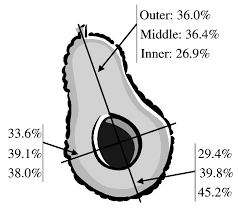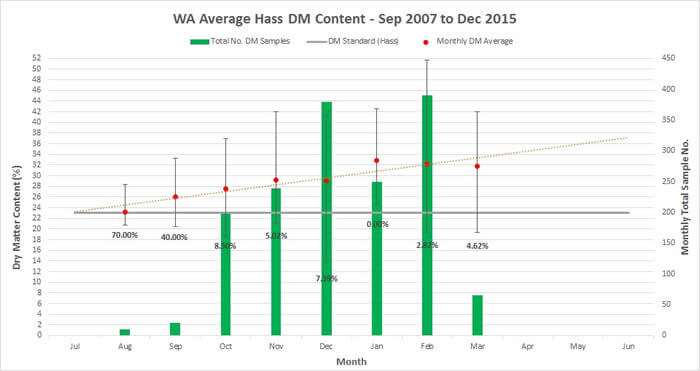July 11, 2019 at 3:50 am | Updated July 11, 2019 at 3:50 am | 5 min read
The avocado is a climacteric fruit that ripens after it is harvested. The fruit needs to be picked when it is physiologically mature to ensure the avocado will continue to ripen properly. Mature fruit will develop varying tastes depending on the variety. But, if premature fruit is picked, flavor development is hindered.
There are many physical values, such as appearance, ripeness, and color, that can be used to judge if an avocado is mature enough for harvest. However, these are subjective and require experience on the part of growers. Dry matter, which is a precise means of detecting maturity, is more reliable for ensuring that the final taste of the fruit meets consumer quality preferences.
The Importance of Dry Matter
Dry matter is the solid content of the fruit minus the water. Thus, dry matter is all of the carbohydrates, vitamins, proteins, fats, fibers, sugars, etc. found in the fruit. As the avocado grows, its dry matter content also increases. Studies have shown that dry matter has proven to be a reliable indicator of flavor, and by extension, consumer satisfaction as well.
Subscribe to the Felix instruments Weekly article series.
By submitting this form, you are consenting to receive marketing emails from: . You can revoke your consent to receive emails at any time by using the SafeUnsubscribe® link, found at the bottom of every email. Emails are serviced by Constant Contact
Dry matter is, however, an indirect indicator of maturity in avocados. The development of the fruit can also be tracked by the increase in the oil content of the fruit.
A minimum of 11.2% oil content is considered necessary to declare a fruit mature. The higher the oil content, the better the fruit tastes. Leaving fruit on the tree longer would allow more oil to develop. However, this would leave less time for transport and storage. The oil content of avocados at maturity will depend on cultivars and the region where the fruit is growing.
However, while oil content is a fantastic indicator of maturity, it is not an easy metric to calculate in avocados.
It has been found that as oil content in avocados increases, water content decreases, because oil replaces water in the fruit. As dry matter is fruit content minus water, it did not long take long before the correlation between oil content and dry matter was established. As oil content increases, the dry matter content increases as well.
Methods to Estimate Dry Matter
Many ways have been used to estimate dry matter with the purpose of determining if avocados are mature enough to be harvested. There are simple conventional – and a few new – methods to measure dry matter content.
Conventional Methods
Here, a sample of fresh fruit is taken. The sample is weighed to obtain the “wet weight”. Fruit is then dried in either an oven or microwave until all moisture has evaporated. It is then weighed again to obtain the dry weight. Dry matter content is calculated using the following relationship:
(dry weight / wet weight) x 100 = % Dry Matter
The disadvantage of this method is that it is destructive, and incredibly time and labor intensive.
New Methods
Among alternative methods, near infrared (NIR) spectroscopy is one of the most popular. It is non-destructive and gives an accurate dry matter assessment (within 1 dry matter unit), and has been integrated into small handheld instruments. Measurements and results can be obtained instantly in the field and in packing warehouses, while the devices themselves are affordable and allow for organization of thousands of readings.
Best Practices With Dry Matter
To estimate dry matter accurately, some precautions have to be taken:
- Test fruits from shady parts of the tree, and select the least ripe-looking fruits.
- Many trees in an orchard should be tested; a single test is not enough.
- Conduct dry matter estimation in the morning with NIR tools. Similarly, for conventional DM estimation, harvest fruit in the morning, since fruit is most hydrated at this time of the day.
- For conventional methods of DM estimation, wrap the fruit in plastic to prevent moisture loss, and conduct the analysis as soon as possible.
- The distribution of dry matter in the avocado is not even from top to bottom, as Figure 1 shows. As a result, dry matter should be measured at the mid point (widest diameter). Measurements should be taken from the same place on ALL fruit.

Figure 1: Dry matter distribution in a Hass avocado. (Image credits: Phetsomphou, V. 2000, http://www.avocadosource.com/Journals/Orchardist/woolfallan2003b.pdf)
Dry matter is checked not only at the time of harvest, but also when it is packed and in storage.
What is the Right Dry Matter Content?
The optimum dry matter content of avocado at the time of harvest is dictated by consumer preference and final quality of the fruit.
Avocados must have a minimum of 21% dry matter before they can be harvested in order to meet consumer tastes. The ideal dry matter content, however, varies. It depends on the variety, season, and region where the avocado is cultivated. The dry matter content for different varieties and regions are:
- 23% for Haas in Chile
- 23% for Haas in Australia
- 21% for Shepard in Australia
- 21% for Haas in Israel
- 23.5% for Haas in Columbia
- 27% for Lamb Haas in South Africa
So, while 23% is the optimum in most parts of the world, avocados in New Zealand are immature if harvested with 23% of dry matter. These standards are set by the governing bodies and are closely monitored.

Figure 2: Dry matter variation over the year in Western Australia. Image credits: https://www.avocado.org.au/best-practice-resource/
Best Practices During Harvest and Storage
After deciding when to harvest, there is still a lot that growers can do to maintain the quality of their fruit. The following are some of the strategies to keep in mind while harvesting and storing avocados…
- Don’t harvest fruit when it is wet – this can increase the chances of rot.
- Don’t harvest when the weather is hot if the fruit can’t be cooled immediately, as this can reduce fruit storage time.
- Hass avocados can be snap-picked when dry but should be snip-picked with secateurs when wet.
- Other avocado varieties should be snip-picked.
- Minimize damage to fruit during transport.
- Keep harvested fruit cool and in the shade.
- Fruit should be packed and cooled within a day of harvest.
- Hass avocados should be cooled to 4°C to 5°C – and other varieties to 6°C to 8°C – to ensure storage for up to four weeks and two weeks, respectively.
- Cool fruit before transporting them.
- Pack, transport, and store avocados in single-layer trays to allow for proper aeration.
The Avocado Quality Meter
Ealier this year (2019), Felix Instuments launched its first in an extensive line of NIR-based dry matter assessment tools for avocado. Calibrated specifically for the ubiquitous Hass variety, the Avocado Quality Meter delivers accurate dry matter readings in the field while fruit is still on the tree or in distribution centers, enabling personnel to take measurements while fruit remains in the cold chain. Given the ever-growing popularity of avocados and the premium price they command, an NIR based quality meter is a must-have for farmers, packers, and suppliers.
Click here – Avocado Quality Meter for more information.
—
Vijayalaxmi Kinhal
Science Writer, CID Bio-Science
Ph.D. Ecology and Environmental Science, B.Sc Agriculture
Source
Blumenfeld, A., Sitrit, Y. and Riov, J. (1986). Avocado fruit ripening and ethylene biosynthesis. Acta Hortic. 179, 787-792 DOI: 10.17660/ActaHortic.1986.179.132
Botha, A. (2017, December). How-to-determine-avocado-dry-matter-content. Subtrop.20. 27
Retrieved from https://www.avocado.co.za/wp-content/uploads/2017/12/How-to-determine-avocado-dry-matter-content-Pg-27.pdf
Carvalho, P. C., Velásquez, M. A., & Van Rooyen, Z. (2015). Determination of the minimum dry matter index for the optimum harvest of ‘Hass’ avocado fruits in Colombia. Agronomía Colombiana. 32. 399-406. 10.15446/agron.colomb.v32n3.46031.
Mccarthy A. (2018, May 17). Avocado maturity testing using dry matter. Retrieved from https://www.agric.wa.gov.au/avocados/avocado-maturity-testing-using-dry-matter?page=0%2C0
Hickson B. (2006, June).Quality assessment of avocados by means of dry matter content. Retrieved from https://www.unece.org/fileadmin/DAM/trade/agr/meetings/capacity-building/ 2006_mojmirovce-SK/Dry%20matt
Lee, S. K. (1982). A review and background of the avocado maturity standard. Calif. Avocado Soc. Yearbook. (1981) 65:101-109.
R. Waissbluth and J. Valenzuela (2007) DETERMINATION OF THE MINIMUM PERCENTAGE OF DRY MATTER TO AUTHORIZE THE HARVEST OF HASS AVOCADO PEARS FOR EXPORT http://www.avocadosource.com/wac6/en/extenso/5b-213.pdf
image credit: Callan Bird
Related Products
- F-751 Grape Quality Meter
- Custom Model Building
- F-901 AccuStore
- F-751 Melon Quality Meter
- F-751 Kiwifruit Quality Meter
- F-750 Produce Quality Meter
- F-751 Avocado Quality Meter
- F-751 Mango Quality Meter
- F-900 Portable Ethylene Analyzer
- F-950 Three Gas Analyzer
- F-920 Check It! Gas Analyzer
- F-960 Ripen It! Gas Analyzer
- F-940 Store It! Gas Analyzer
Most Popular Articles
- Spectrophotometry in 2023
- The Importance of Food Quality Testing
- NIR Applications in Agriculture – Everything…
- The 5 Most Important Parameters in Produce Quality Control
- Melon Fruit: Quality, Production & Physiology
- Fruit Respiration Impact on Fruit Quality
- Guide to Fresh Fruit Quality Control
- Liquid Spectrophotometry & Food Industry Applications
- Ethylene (C2H4) – Ripening, Crops & Agriculture
- Active Packaging: What it is and why it’s important






